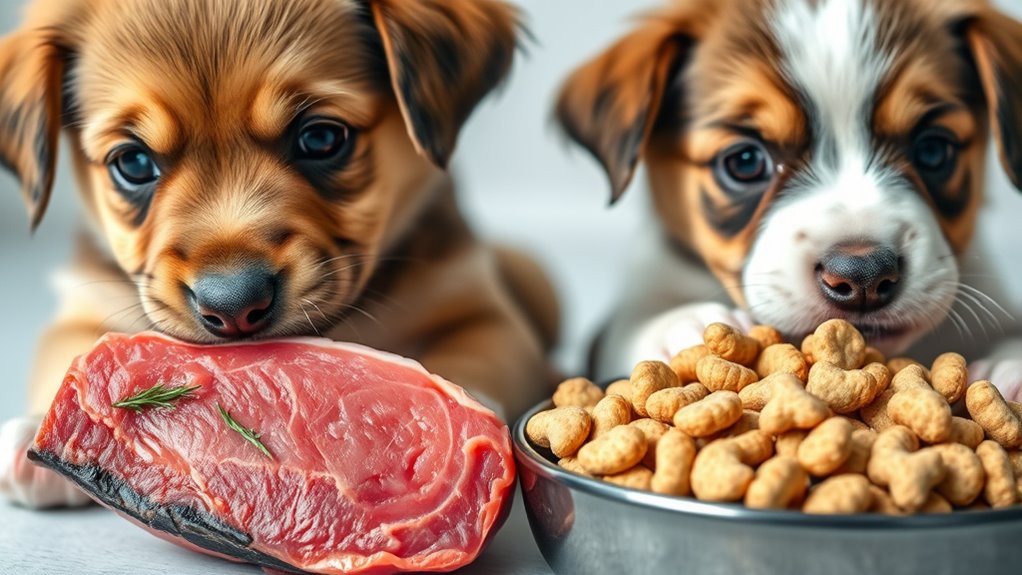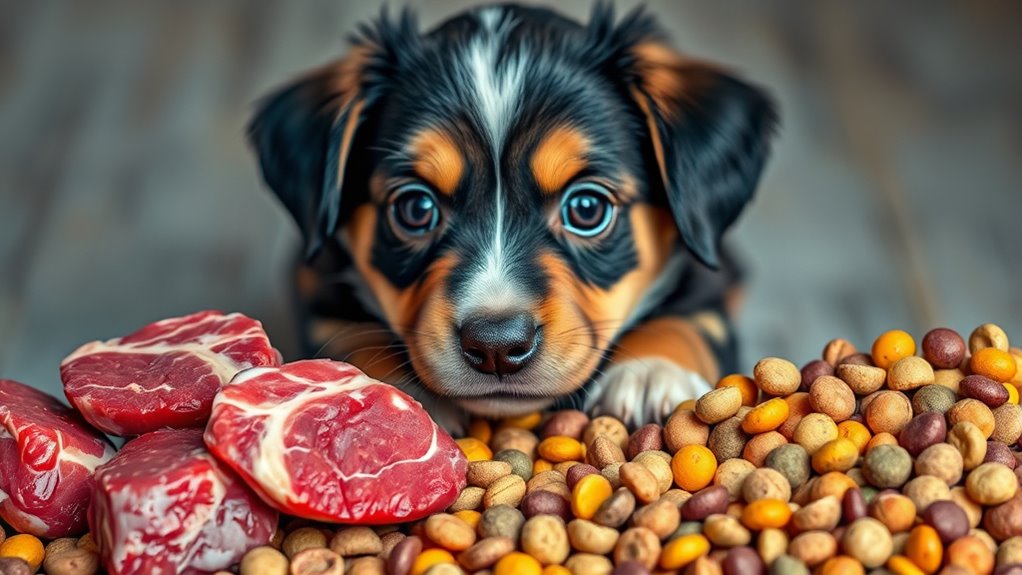Choosing between raw and kibble for your growing puppy depends on your ability to provide balanced, nutritious meals. Raw diets can mimic natural eating habits and offer enzymes, but they need careful formulation to prevent deficiencies. Kibble is convenient, pre-measured, and designed to meet puppies’ nutritional needs. Both options influence your pup’s health and development, so understanding their differences helps you make the best choice—plus, you’ll discover key tips for optimizing your puppy’s diet.
Key Takeaways
- Raw diets closely mimic natural prey, providing enzymes and fresh nutrients, but require careful formulation to prevent deficiencies.
- Kibble offers a convenient, balanced, pre-measured diet ideal for consistent growth and easier feeding routines.
- Proper nutrition in both options supports healthy weight gain, strong bones, and overall development during puppy stages.
- Raw feeding demands strict schedules and preparation, while kibble simplifies portion control and storage.
- Regular vet checkups help monitor growth and ensure the chosen diet maintains optimal health for puppies.

Are you unsure whether raw or kibble food is best for your puppy? Deciding between these options can feel overwhelming, especially when you want to give your new furry friend the best start in life. One of the most important factors to consider is how each feeding choice impacts your puppy’s growth and development. Proper feeding schedules are essential to ensure your puppy gets consistent nourishment, regardless of whether you opt for raw or kibble. It’s equally vital to focus on achieving a nutritional balance that supports healthy weight gain, strong bones, and a shiny coat.
Proper feeding schedules and balanced nutrition are key for your puppy’s healthy growth.
When considering raw food, you might think it closely mimics what puppies would eat in the wild, offering natural enzymes and fresh ingredients. However, feeding raw requires a strict schedule to prevent overfeeding or underfeeding, which can lead to nutritional imbalances. Puppies need frequent, smaller meals throughout the day to support rapid growth, so you’ll need to establish a consistent feeding schedule that suits their age and energy level. If you choose raw, you’ll want to ensure the diet is carefully formulated to include a proper mix of proteins, fats, and essential nutrients. Without this balance, your puppy could develop deficiencies or excesses that hinder healthy development.
Kibble, on the other hand, offers the convenience of pre-measured portions and a more straightforward feeding schedule. Many commercial formulas are designed to deliver a balanced diet, making it easier to maintain your puppy’s nutritional needs. It’s crucial, though, to select high-quality kibble that lists real meat as the primary ingredient and is formulated specifically for puppies. Even with kibble, you should pay close attention to feeding schedules—feeding your puppy at regular times helps prevent overeating and promotes good digestion. The packaging usually provides guidance on portion sizes based on your puppy’s age and weight, helping you maintain a consistent nutritional balance.
Additionally, the contrast ratio in your puppy’s diet can influence the quality of their coat and overall health, making it an important consideration regardless of whether you choose raw or kibble. Whichever option you choose, sticking to a reliable feeding schedule and monitoring your puppy’s growth are key. Regular vet checkups can help verify that your puppy’s nutritional needs are being met and that they’re developing properly. Keep in mind that a balanced diet isn’t just about what you feed but also about how often and in what quantities. Whether raw or kibble, your goal is to establish a routine that provides steady energy, supports healthy growth, and nurtures your puppy into a happy, healthy dog.
Frequently Asked Questions
How Do Raw and Kibble Diets Affect a Puppy’S Dental Health?
You might notice that diet impacts your puppy’s dental health by influencing dental plaque buildup and tooth wear. Raw diets often help reduce plaque because chewing raw meat and bones cleans teeth naturally. Kibble, however, can sometimes cause more tooth wear due to its abrasive texture. Regular brushing and dental check-ups are essential, regardless of diet, to keep your puppy’s teeth healthy and prevent dental issues.
Can Switching Between Raw and Kibble Cause Stomach Upset?
Switching between raw and kibble can cause stomach upset if you’re not careful. Your puppy’s digestive system needs time for proper adaptation, so sudden changes can lead to discomfort or diarrhea. To avoid this, maintain feeding consistency and introduce new foods gradually. This helps your puppy’s digestive system adjust smoothly, reducing the risk of upset and ensuring they stay healthy and happy during dietary shifts.
Is One Diet More Cost-Effective for Growing Puppies?
You’re wondering if one diet is more cost-effective for your growing puppy. When you do a cost comparison, kibble often wins because it’s generally cheaper and easier to store. However, raw diets may offer higher nutritional value, which could lead to fewer vet bills long-term. Consider your budget and your puppy’s specific needs to decide whether the immediate savings of kibble outweigh the potential benefits of raw feeding.
How Do Raw and Kibble Diets Impact a Puppy’S Energy Levels?
You might notice that diet influences your puppy’s energy levels and activity. Raw diets often promote better energy stability, helping your pup stay active and alert throughout the day. Kibble can provide quick energy but may lead to fluctuations in activity levels. To support consistent energy, choose a diet tailored to your puppy’s needs, and monitor their response to guarantee they stay lively and healthy.
Are There Breed-Specific Considerations for Raw Versus Kibble Diets?
When it comes to breed-specific considerations, you need to keep your ear to the ground. Some breeds have dietary restrictions or unique needs, making one diet more suitable than the other. For example, small breeds might thrive on kibble for convenience, while certain large breeds benefit from raw diets to support joint health. Always consider breed preferences and consult your vet to tailor the best plan for your puppy’s growth and well-being.
Conclusion
Ultimately, choosing between raw and kibble depends on your puppy’s needs and your lifestyle. Imagine fostering a lively Labrador puppy who thrives on balanced raw food, gaining energy and a shiny coat. Or consider a busy owner sticking to high-quality kibble for convenience. Whichever you choose, prioritize your puppy’s health and happiness. Because your decision today shapes a strong, happy companion for years to come.










